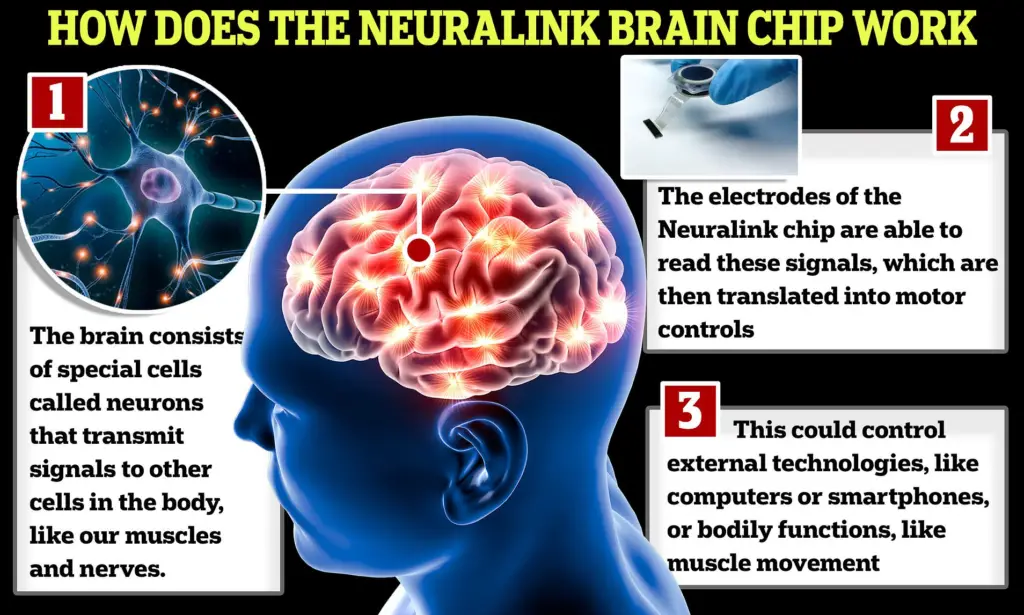In order to develop implanted brain-machine interfaces (BMIs) that would allow users to communicate directly with computers and other devices, Elon Musk founded Neuralink in 2016. The Wall Street Journal revealed Neuralink in 2017.
Musk and other Neuralink executives gave a livestreamed presentation in 2019 to unveil the company’s tech.
The Neuralink technology aims to create a high-bandwidth, two-way connection between the human brain and an external computing system. The ultimate objective is to enable humans to establish a symbiotic connection with artificial intelligence through enhancing cognitive and sensory capacities (AI).
What is Neuralink?
The Neuralink device, also known as the “neurachip,” is a tiny implantable chip that is designed to be inserted into the brain through a very small incision made by a specialised robot. The device contains a number of tiny electrodes that can be used to record and activate brain activity.
The impulses are then wirelessly transmitted to a computer, which can interpret and respond to them. In order to better understand how the Neuralink gadget may be used to control motor movements and restore sensory capacities, researchers are now testing the technology on animals like as mice and monkeys.
Although it hasn’t been tested on humans yet, the company has stated that it would shortly apply for regulatory approval for human trials.
How Neuralink will work?
Neuralink is creating two devices. The first is a chip with electrodes implanted in a person’s skull.
Electrodes thread through the chip behind the ear. Neuralink’s coin-sized chip would be implanted in the skull. The chip sends a network of 20-nanometer wires into the patient’s brain.
1,024 electrodes on the wires can monitor brain activity and theoretically stimulate it. The chip wirelessly sends this data to computers for researchers to study.
The second is a chip-implanting robot. A sewing machine-like robot would punch flexible wires from a Neuralink chip into a person’s brain with a stiff needle.

Functions of Neuralink
Neuralink’s working principle is as enlightening as its design concept. These features illustrate NEURALINK’s operational processes:
1- It sends brain signals to the computer wirelessly. Low-energy module allows wireless transmission.
2- These flexible-threaded nodes connect to the cortex and transfer massive amounts of data between the two interfaces.
3- Elon Musk’s official memorandum states that these transmission threads can contain 3.072 electrodes per array across 96 threads and are micron-scaled with a width of 4-6 um.
4- Processed electrodes send low-level electric current to the brain. In the meantime, synapsis between neurons maintains a magnetic field that allows electric charge to flow between the brain and the computer.
6- This produces amazing computer-screen sensations.
Uses of Neuralink
- It detects and treats pathological and neurological disorders.
- It addresses memory loss.
- Be able to address depression, hearing loss, paralysis, addiction, and anxiety.
- Create a visual prosthesis and use telepathy.
- Disease prediction (e.g., Parkinson’s).
- Identify psychological issues.
- Let your creativity flow.
- Neurosurgery by robot.
Disadvantages of Neuralink
1- Neuralink develops electrode transport systems using super-thin threads. These threads would create a powerful brain-machine interface when implanted in the brain. Getting these tiny wires, thinner than human hair, past the skull and into the brain is difficult. Thus, Neuralink is developing a tiny robot to connect the electrode to humans via Lasik-like surgery.
2- Read the appropriate neural activity. Due to brain complexity, the device may take time to connect to brain signals.
3- It cannot detect brain cell activity.
4- Electrodes may cause scar tissue damage. Feedback may be inaccurate.
Does Neuralink revolutionize modern medicine?
Neuralink uses long-standing technology. Elon Musk’s company has compacted the technology into a tiny implantable device and is trying to make it affordable and upgradable.
Neuralink treats memory loss, hearing loss, blindness, paralysis, insomnia, extreme pain, seizures, addiction, strokes, brain tissue damage, and more by augmenting damaged nervous system areas. More importantly, Musk wants Neuralink to launch a new era of computing and machine interaction.
Depending on FDA and clinical trials, Elon Musk’s Neuralink may revolutionize medicine. Since the technology needs a lot of outside developers.
What Scientists say about Neuralink?
The potential consequences of neural connection technology are extensive and far-reaching. It may be used to treat neurological diseases like Parkinson’s disease or epilepsy by directly activating certain brain regions. Additionally, it can be used to enhance cognitive abilities like memory and learning, as well as provide people the power to control other objects with their thoughts.
Some experts have expressed concern about the ethical implications of brain-machine interfaces, particularly in relation to privacy, security, and the potential for abuse. The technology also raises questions about the potential for a human and AI union, as well as the benefits and cons of such a connection.
Michio Kaku examines the potential for “neuroprosthetics” to enhance human memory, IQ, and sensory abilities in a chapter on brain-machine interfaces in his book “The Future of Humanity.” He also looks at the ethical implications of this technology, such as the need for privacy and security protection, the potential for unequal access, and other concerns.
In his book “The Age of Spiritual Machines,” Ray Kurzweil explores the concept of “cyborgs” and the fusion of human and machine intellect. He discusses how brain-machine interfaces could enhance human cognition and overcome physical challenges like blindness or paralysis.
In a world where people and technology are becoming more and more interconnected, he also voices concerns about the potential loss of personal freedom and identity. Both books provide a more thorough background and discussion of the possible impacts of brain-machine interfaces, which may aid in our understanding of Neuralink and other related technologies.



